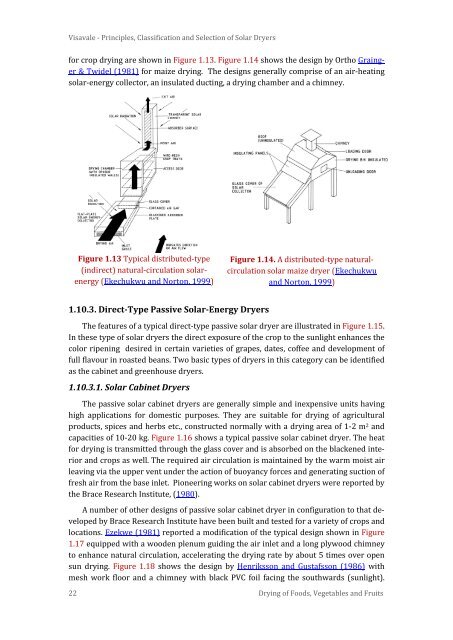Solar Drying: Fundamentals,Applications and Innovations - National ...
Solar Drying: Fundamentals,Applications and Innovations - National ...
Solar Drying: Fundamentals,Applications and Innovations - National ...
Create successful ePaper yourself
Turn your PDF publications into a flip-book with our unique Google optimized e-Paper software.
Visavale - Principles, Classification <strong>and</strong> Selection of <strong>Solar</strong> Dryers<br />
for crop drying are shown in Figure 1.13. Figure 1.14 shows the design by Ortho Grainger<br />
& Twidel (1981) for maize drying. The designs generally comprise of an air-heating<br />
solar-energy collector, an insulated ducting, a drying chamber <strong>and</strong> a chimney.<br />
Figure 1.13 Typical distributed-type<br />
(indirect) natural-circulation solarenergy<br />
(Ekechukwu <strong>and</strong> Norton, 1999)<br />
Figure 1.14. A distributed-type naturalcirculation<br />
solar maize dryer (Ekechukwu<br />
<strong>and</strong> Norton, 1999)<br />
1.10.3. Direct-Type Passive <strong>Solar</strong>-Energy Dryers<br />
The features of a typical direct-type passive solar dryer are illustrated in Figure 1.15.<br />
In these type of solar dryers the direct exposure of the crop to the sunlight enhances the<br />
color ripening desired in certain varieties of grapes, dates, coffee <strong>and</strong> development of<br />
full flavour in roasted beans. Two basic types of dryers in this category can be identified<br />
as the cabinet <strong>and</strong> greenhouse dryers.<br />
1.10.3.1. <strong>Solar</strong> Cabinet Dryers<br />
The passive solar cabinet dryers are generally simple <strong>and</strong> inexpensive units having<br />
high applications for domestic purposes. They are suitable for drying of agricultural<br />
products, spices <strong>and</strong> herbs etc., constructed normally with a drying area of 1-2 m 2 <strong>and</strong><br />
capacities of 10-20 kg. Figure 1.16 shows a typical passive solar cabinet dryer. The heat<br />
for drying is transmitted through the glass cover <strong>and</strong> is absorbed on the blackened interior<br />
<strong>and</strong> crops as well. The required air circulation is maintained by the warm moist air<br />
leaving via the upper vent under the action of buoyancy forces <strong>and</strong> generating suction of<br />
fresh air from the base inlet. Pioneering works on solar cabinet dryers were reported by<br />
the Brace Research Institute, (1980).<br />
A number of other designs of passive solar cabinet dryer in configuration to that developed<br />
by Brace Research Institute have been built <strong>and</strong> tested for a variety of crops <strong>and</strong><br />
locations. Ezekwe (1981) reported a modification of the typical design shown in Figure<br />
1.17 equipped with a wooden plenum guiding the air inlet <strong>and</strong> a long plywood chimney<br />
to enhance natural circulation, accelerating the drying rate by about 5 times over open<br />
sun drying. Figure 1.18 shows the design by Henriksson <strong>and</strong> Gustafsson (1986) with<br />
mesh work floor <strong>and</strong> a chimney with black PVC foil facing the southwards (sunlight).<br />
22 <strong>Drying</strong> of Foods, Vegetables <strong>and</strong> Fruits

















